#but traditional art and the practice of putting ink to paper is satisfying in a tactile way that digital art isn't
Note
Hey Sergle, how does one learn how to draw? Like, I am in my 20s, can barely draw a stick figure, and feel overwhelmed whenever I try to look up tutorials. Do you have any advice on how to start?
my Unprofessional advice on how to start in earnest, is to do it the way little kids do when they start learning to draw! which is to not approach it as learning at all. sitting down and scribbling out whatever comes to mind, reading a book or watching a movie and trying to copy the way the characters are drawn. draw a page full of cats. do it while you watch tv. doing all that w/o the Grown Up impulse to be embarrassed that you're new at a skill.
#I don't care if this advice isn't structured- i think this is the more fun way to learn!#I could send you a masterpost with links on tutorials and How Tos and Beginner Guides For Dummies etc but that's not.. the way I think#that it should work.#you could take a class or follow tutorials you find on yt and that's fine too. but like you said#it's overwhelming that way. bc then it feels like homework. and then it feels like there's a Certain Way to do it#and if there's a certain way to do it then that means there's a wrong way to do it.#oh the second part of this advice is to use physical art supplies. digital art is amazing#but traditional art and the practice of putting ink to paper is satisfying in a tactile way that digital art isn't#and you don't have to Set Up any art program to have the exact like. tablet settings you want#idk baby you should just pick up some art supplies that inspire you and get the ball rolling#steal some watercolor from hobby lobby if you must! paint some flowers. or some shit! have fun!#sergle answers
263 notes
·
View notes
Text
It's way past my bedtime ans my cat is sleeping-purring next to me but I thought I'd post the process of the @ailani-reillata Ailaniversary art I made today just to talk a bit more about it
Disclaimer: doing traditional art is cool until you need to scan it or post a picture of it 😂 also kinda long post below so ofc no obligation at all to read it!
Phase one: Sketching the Idea
My inspiration for the posture was a Yara Flor comic strip I found on Pinterest. Yara looks over her shoulder and her hair falls on the side of her face, and I loved the way it framed her face and thought it would look great with Ailani's hair.
I drew a little doodle on the page to help me visualize how the hair would be divided, and focused on 3 main parts (the lines, the bubbles, the empty space) which would - supposedly- help me during the lineart stage. Below are images of the final sketch.
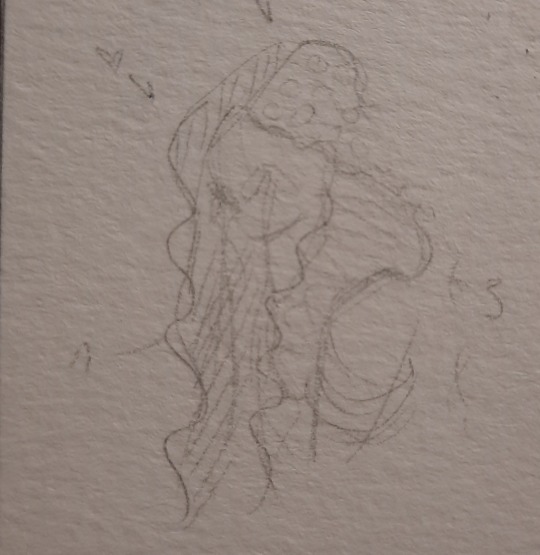


I was hesitant on adding details to her arms, such as the folds of a dress, but I was so anxious about ruining the drawing I abandonzd that idea. I was considering adding her tattoos and was still not decided at this stage of the drawing.
Phase 2: Line-ing the Art
Is that even a real word? Idk, I'm too tired to English properly so we will say it is. Following the sketching phase was naturalle the lineart phase, which is one of my favorite stage when drawing. I bought new inking pens too so I was able to test them out, and it went quite well!
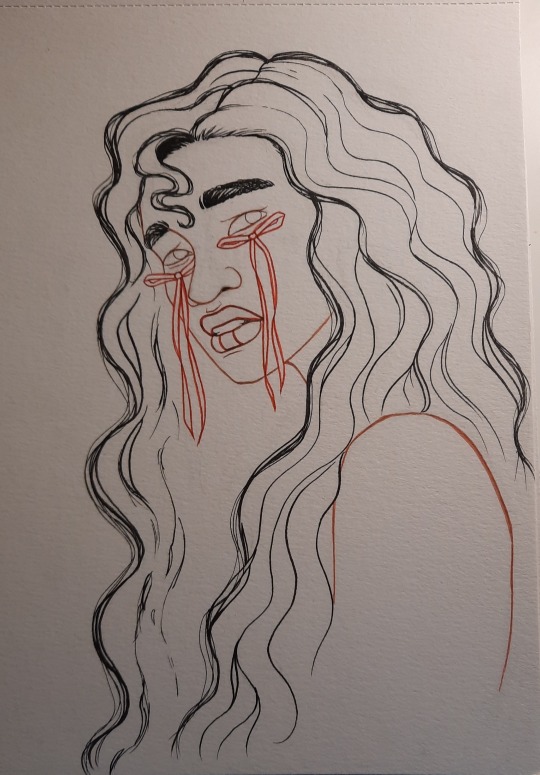
As you can see, the ribbons, outline of the skin and facial features have been done with my new pens, and i was quite happy with the result! It gives a more natural look to the whole drawing in my opinion.
At this stage I decided not to add her arm tattoos and consider this version of Ailani as the one you would find in the early chapters of Begged and Borrowed Time, so before she would get her tattoos.
Phase 2.5: Line-ing the Hair
This stage has it's own part because it was really fun to do! The inspiration for the way I draw hair comes from @/ssavaart (aka Scott Christian Sava on Youtube). I've been following him for a while now and I'm trying to push my art beyond my comfort zone and try new stuff thanks to him, and having fun with drawing hair is one of these things!

Look how beautiful these curls are. I'm not trying to toot my own horn or anything, but I'm really proud of the drawing at this stage 😂 it's the perfect moment where the inking went well and I have not yet ridked myself with the watercolours - so I always take a long sight (and tons of pictures) to celebrate reaching this stage without incidents.
Phase 3: Watercolours
Here comes the difficult part. It always makes me nervous because I always fear ruining my drawing and all the efforts I put into it by doing the watercolours. But I love the medium too much and if I want to get better I need to practice. So, testing the waters, I finally dive head first into this crucial stage.
The watercolouring goes well, I'm overall satisfied enough to take some pictures and even try to scan it, with the hope that the scanned rendering will be better than the usual "photographing and editing" I do with my phone.
Spoiler alert: the scan was NOT better than the pictures, and no amount of editing could change that. (Or maybe I am just very bad at editing.) So, back to my "photographing and editing" habits, I somehow managed to get a good enough result:
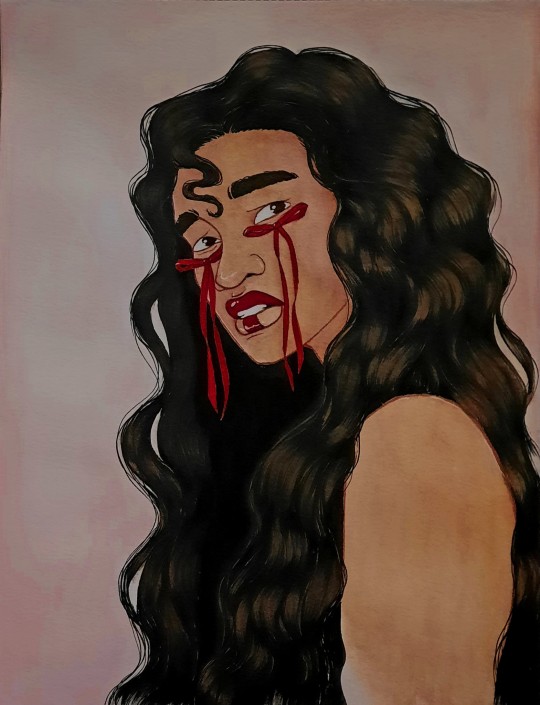
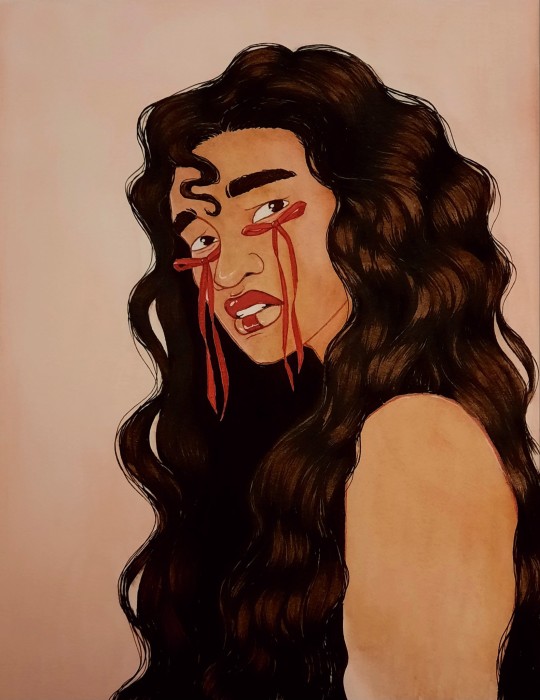
I still feel unsatisfied as I find these digital versions do not properly render the visuals I have on paper, IRL. With the digital versionsw the hair is either so dark we don't see the details, or too bright, the colours are too warm and light... And while Ailani looks light-skinned, the paper version has these visible brown tones that I struggled to find on the digital version, even when editing the pictures. The closest I got is the tone you see on the first picture, but the image is not lighted enough so the overall quality of the picture is a bit lessened by that.
Still, I won't complain too much, because overall it was a very fun drawing to do, I enjoyed every stage of it and I would love to do another piece like this! But for now I will go to sleep because it is Way Past My Bedtime 😂
If you've made it this far, thank you for your attention, feel free to let me know which stage is your favorite and what you liked most (or disliked most) about this drawing!
I for one really had fun doing Ailani's lips, as well as filling her hair, and colouring her eyes! 😊
#ailani#ailani art#I'm tagging just in case you wanna see more but again no obligation to read all of that or anything!#this post is mostly here to show the early stages coz I was so prouf of how smoothly it went!!#until the colours#it's always the colours 😂#but I hope you enjoyed the drawing anyway#I've actually been working on it last weekend but couldn't finish it until this saturday because of my exams week#which is over btw which means i finally has time to read Begged And Borrowed Time!!#and I'm really excited about that!!#so yeah that's all for me now is time to sleep because it's like 4:19am right now and I am huu tired 😂#once again happy Ailaniversary 💕💙#also yes we can't see my signature on the drawings I cut it out by accident when i cropped the pictures and was too lazy to retake pics etc#please pretend like you see my name signed next to her hair x)
7 notes
·
View notes
Text
Evaluative statement PP2
I learned a lot in my second year. I also end it with a lot of questions and ideas in my head.
First of all I will talk about my feelings after the museum/gallery visits of this second year.
In a second time, I will talk about the workshops, what they brought me and the impact they had on my work and my progress as an artist.
Then I would talk about the development of my practice, the tools and support I have used.
Finally, I would talk about my plans for the future and my professional projects.
This year I had the chance and opportunity to visit several museums and galleries. However, I regret not having managed my time better to go to more openings and exhibitions. As an artist I am curious about the work of others and I am also deeply convinced that it is important for my own work to document, inspire and feed off from the work of other artists. I also believe that visiting museums/galleries is a way to expand my culture and my knowledge of art history. This year I have noticed that I have taken the time to linger and take a more constructive look at the sculptures, especially the one by Rodin and Bourdelle at the Cardiff Museum. In the past I tended to focus on paintings, especially those from the Romantic period and pop art in general, but I think that what has really changed this year is that I really tried to find what I like in every new thing I discover or contemplate.

This year, there were two key workshops, including discussions with the professors leading these workshops, which gave me a lot for the development of my practice. I had the impression of finding myself much more in the themes of this year's workshops, which motivated me even more to think about how I could improve my practice and my work in general by giving me the courage to take risks in relation to new things I have experienced and where a satisfactory result was not guaranteed. I also felt that I finally did allow myself to try to really take seriously the advice given to me by the teachers for the paintings. The workshops really had a key role for me this year because I really feel that I have progressed but also matured at the same time. A large majority of my body of work from the first semester was based on the workshops I attended.
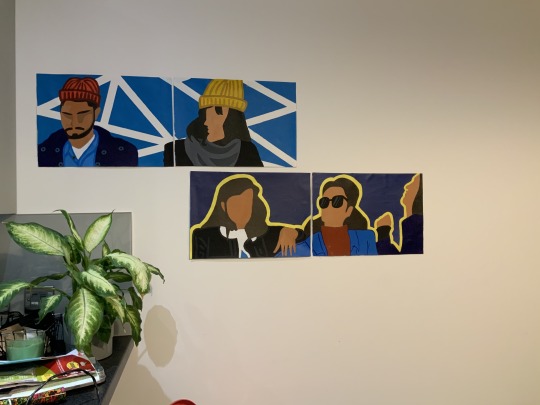
This year I really used a lot of different new tools. As far as regards of my painting I stayed on a dominant base of acrylic paint but I also experimented with Indian ink. What has changed compared to the previous year is really the size and the media I used. I used to not really go beyond A4 and use paper but this year I switched to cotton canvas and made several large formats. I also bought more brushes of different sizes that I use depending on the precision of what I need to paint. I used tape and pieces of cardboard that are "everyday" objects in order to make quick and easy patterns for my background. Finally, thanks to my new graphic material : my tablet, I had the possibility to work and develop my characters and their clothes in a virtual way by taking pictures of my background and making graphic sketches on it in order to create a model/ a work guide. This tablet and especially the "Procreate" application opened the doors to many possibilities for me in terms of illustration. Throughout the year I had the time to familiarize myself with this application, so I created illustrations from photos or images from movies, series, internet etc. I was also able to spend time developing my own characters and try my hand at creating several comic book boards. I am very satisfied with what I have produced with this software however I consider that this work is still part of "research" and that I still don't really have something really specific to myself. I also have the impression that thanks to this software I have progressed in the way I tune and choose different colours and I feel it in my paintings as well.
As I gave up on my idea of getting transferred during my undergraduate studies in Toronto, I decided to really dedicate my last year of studies in England to my practice in order to really be up to speed and to have an interesting profile to be able to start my professional life properly. Once I've graduated I plan to return to France for maybe 5-6 months, find a small job in my field or even an internship to gain experience while devoting these few months to familiarize myself with and master software such as Photoshop and Adobe InDesign. I would also like to take an English certification diploma in order to have a level certificate. As English is not my birth language, I wouldn't want this to be a problem for me to find a job. I also plan to put money aside while applying remotely to find a job in Toronto. The idea would be to move once I'm hired and use the half of the money set aside to settle down. My father grew up and spent the first 25 years of his life in Canada and my mother studied in Canada, so it's a bit of a family tradition to make a move there. Also, as a Canadian citizen, I could start working as soon as I arrived on Canadian soil. Out of curiosity I went to see the current job offers compatible with my future degree in Toronto proposed on the Indeed site and I could see that there were quite a few interesting jobs in the field of illustration and animation offering very decent salaries.
I'm really happy with this second year. I really feel like I'm progressing towards who I would like to be as an artist. I think the second year of a degree is really about experimenting and creating a base of work and I really feel like I've been able to accomplish that.
0 notes
Text
Essay代写:Modern urban painting
下面为大家整理一篇优秀的essay代写范文- Modern urban painting,供大家参考学习,这篇论文讨论了现代都市绘画。如今,现代都市不仅是都市人的栖身之所、艺术活动的承载之地,更是反映时代的宏大景观,绘画视角应当更有当代的都市气息,真切地反映现实生活,这也是绘画的发展趋势,在许多大型美术展览上都能感受到。���论是探讨社会变迁的身份问题,还是快节奏下的生存状态,现代都市绘画都具有非常多的可能性,它本质上就是都市人对于自身和环境的思考。
Since the reform and opening up, economic construction has become the theme of The Times. As a special economic zone, shenzhen has created a miracle attracting worldwide attention. In this context, modern urban painting has very distinct practical significance and characteristics of The Times. With the development of society and the prosperity of civilization, the painter's expression and understanding of the city gradually entered into his painting works. At the same time, it was accompanied by the process of city commercialization. Take shenzhen as an example. This is a process of "city" and "city". Because of the decision to set up special economic zones, because of the "city" and "city", economic construction developed, and then because of the "city" and "city", promote the renewal of the city construction, high-rises rise. "City" because of "city" is the impetus of policy, "city" because of "city" is the drive of interest, which is exactly in line with the theme of "economic construction as the center", its essence is to pursue interests and build. Reclamation, opening mountains, digging tunnels, building airports, ports, high-speed rail, subway... Everything paves the way for faster economic construction. Model commercial real estate development, construction of residential buildings, office buildings, shopping square... There are stylized branches of big brands in the square, companies set up in the office buildings are involved in real estate, finance, Internet, high-tech, and residential buildings are all people indirectly involved in or building this model.
Faced with such a modern and commercial city, should painting take the initiative to reflect the current social situation? Are they thinking differently than they used to? Do you dig, examine, and criticize the hearts of the people who live in this glass and concrete forest? This necessity cannot be ignored. The modern urban painting we discussed was born under this background and theme of The Times. This is a discussion based on the perspective of shenzhen with local characteristics.
Is the scenery in the city or in the countryside? This question actually asks about the aesthetic tendency, there is no definite answer. However, according to the custom, they are all "to the countryside to sketch", and the traditional art education is "close to the countryside, far from the city". Undeniably, the beauty of light and color in nature is indispensable in the training of color painting. French impressionism and Russian touring exhibition school of landscape painting have exerted an important influence on the creation and education of landscape painting in China, and this established aesthetic mode seems to have never been out of date. The articles published by the educational module of lu xun academy of fine arts in the journal are indeed as the author said, "repeating the same old tune", which is inseparable from the paradigm of modeling, aesthetics and technology. Under the influence of the teachers, the students went to the countryside to sketch, regardless of the course requirements, giving people a feeling that the painter should "avoid the city" self-cultivation. This mass sketching movement has become a kind of tourism industry, such as the "painter's village" in anhui province, which is also constantly building new archaized hui-style buildings and archaized inns catering to painters and tourists. Artists sometimes avoid overly "artificial" cities and just go to another "artificial" environment, but their plots of sketching can be satisfied. The author also had this kind of sketch plot, go alone tour mountains of ethnic minority autonomous region sketch, but the more begin to reflect on their own works, the men of the city is keen to show the beautiful scenery of the countryside and color, can not think, rural people are yearning we live in a city, our performance was good for the locals is an insurmountable barrier? With the mentality of tourists, it seems that we can never understand the real state of people and nature at that time. Of course, we can also practice our own modeling, aesthetics and technology regardless of everything.
Art comes from and reflects real life. There are also some local old painters in shenzhen who put their eyes on the city of current life, such as li chuchi's "chiwan golden autumn" and he zhenxiang's "one of the dreams of new port", which are the expression of shenzhen chiwan port and yantian port docks, which are works reflecting real life. Facing the wave of reform and opening up and urban construction, what we are facing is the scenery that our predecessors have been looking forward to for a long time.
The concept of shanshui city was first put forward by Mr. Qian xuesen in 1990. The first is the harmony and unity between man and nature, the second is the harmonious development of natural environment and artificial environment, and the third is the combination of Chinese classical cultural tradition and foreign advanced culture and architectural technology. After seeing the works of shenzhen painters, Mr. Qian came up with the idea of "urban landscape painting". Since 1992, the subject of "urban landscape painting" has been concerned by many artists from all over the country. Painter song yuming is one of them, "shenzhen xiaomeisha summer" is his work, this painting is "urban landscape painting" representative of the early works. According to song yuming, it is particularly important to "restore" the spiritual core of the city in his works and reflect his own profound experience in it.
In the "impression city -- contemporary urban landscape painting nomination exhibition" held by wuhan art museum in 2010, nine artists jointly depicted various modern cities at home and abroad, most of whom experienced the "urbanization" period of the construction of new China and the reform and opening up. The works exhibited in this exhibition have a wide range of contents, including shopping malls, hot and dry noodle shops on the streets of Shanghai, high-rise buildings in Hong Kong, European churches, trams and so on. The works have different styles and techniques. Fan feng, the artist and curator of wuhan art museum, said that although ancient paintings like "riverside scene at qingming festival" have been used to depict urban life, urban landscape painting lacks references and mature techniques, which pose challenges for future creation.
In modern urban painting, the combination of ink and wash materials is one of the directions. Can "urban landscape" combine modern urban landscape with traditional Chinese painting with literati interest? It is still worth discussing the effect and degree of freedom of the strong psychological conflicts in individual's spiritual life under the background of "urbanization" while the traditional media show the city image.
Modern city is not only a place for urbanites to live and a place for artistic activities, but also a reflection of the grand landscape of The Times. Our painting perspective should be more contemporary and truly reflect real life, which is also the development trend of painting and can be felt in many large art exhibitions. Whether it is to discuss the identity of social changes or the living state under the fast pace, modern urban painting has a lot of possibilities. It is essentially the reflection of urban people on themselves and their environment.
想要了解更多英国留学资讯或者需要英国代写,请关注51Due英国论文代写平台,51Due是一家专业的论文代写机构,专业辅导海外留学生的英文论文写作,主要业务有essay代写、paper代写、assignment代写。在这里,51Due致力于为留学生朋友提供高效优质的留学教育辅导服务,为广大留学生提升写作水平,帮助他们达成学业目标。如果您有essay代写需求,可以咨询我们的客服QQ:800020041。
51Due网站原创范文除特殊说明外一切图文著作权归51Due所有;未经51Due官方授权谢绝任何用途转载或刊发于媒体。如发生侵犯著作权现象,51Due保留一切法律追诉权。
0 notes
Text
Hylophobia Response:
In this blog post, I will be responding to the research I did on Hylophobia and it’s connection to witchcraft.
Developing from my comic panels and exploring work done by Jamie Hewlett, I went down to the local woods in my area and drew observational drawings of trees using a fineliner.


Following Hewlett’s drawing style of creating the rough texture of the tree trucks via repeated patterns and mark making. By doing this my drawings are given more definition and look more 3D. The overall look of these trees is illustrative and they have a fantasy element to them due to the graphic hand rendered approach.
Dry Point

In the past I have used Dry-point print as a method of illustration due to its raw hand rendered results. Starting by etching my observational drawings of trees into the silicone, I then inked the plate which resulted in the image below. The overall composition is interesting and I’m pleased that this method has picked up the detail of the trees texture. The appearance is very mystical and creepy and I feel the dry point printing process has given it an atmosphere of mystery. Even the marks made by left over ink on the palette has given it a fog like texture.

Satisfied with the results I then began to experiment with them to see what outcomes could be developed. I first copied the image onto black sugar paper and then poured bleach over the image which chemically reacted with the paper turning it white but it didn’t react to the printing marks which allowed the detail to be seen easily. This method created tone in my work and also created a nice contrast to the rawness of the dry-point and the looseness of the bleach effect.
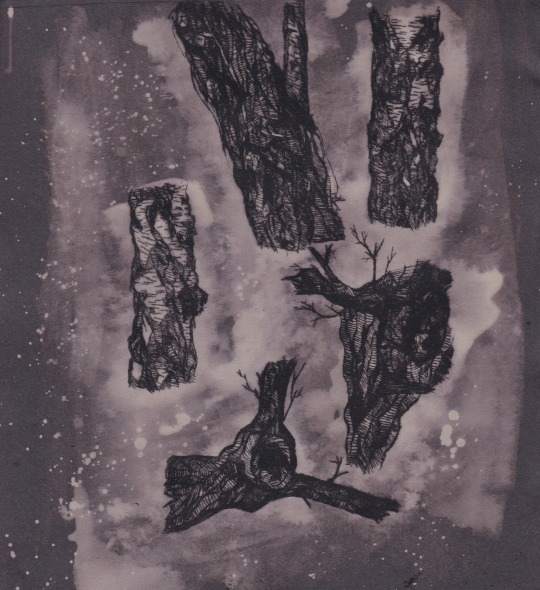
Animation
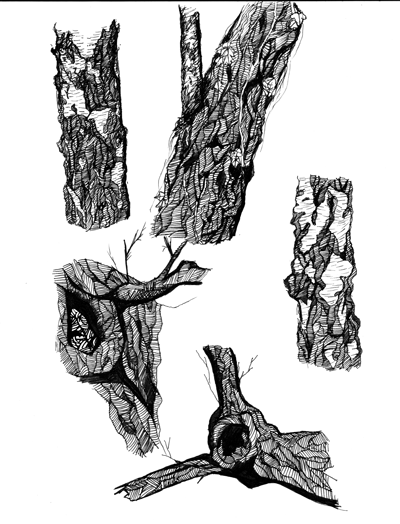
Taking inspiration from our Avatar artist, Lilli Carre, I decided to develop my observational drawings into a 2D animated gif. Looking at the shapes of the trees I imagined the circular patterns to open up like eyes and found that eyes have a common relationship to witchcraft and spiritual practice (e.g. the third eye).
Any problems?
I decided to use the 2D drawing, animation method to contrast with the hand rendered drawing style of the trees which was a slow process and I found difficulty in lining up each frame due to the amount of detail in the texture. This can be seen with the tree in the right hand corner which isn’t as sharp and clean as the one above it, however, I find this shows individuality as it gives them different personalities. With the drypoint, I struggled due to my lack of understanding of tools and processes but after producing these outcomes I now feel more experienced in this field.
Will I use these methods in the future of this project?
I found my gif to be successful as it’s very illustrative and also creates a fantasy like atmosphere. It also allows me to create more hand rendered work that I can develop into 4D work. My drypoint created illustrative designs as well and I wouldn’t mind converting it also into a 4D design but that would take time to etch out each frame so for this project that is highly unlikely. I would like to attempt to create some more witch inspired work so I should look into how witches and witchcraft has been recorded in art through history.
Response to Hylophobia:
Whilst reading about forests and their connection to witchcraft, I came across the Aokigahara forest in Japan, just North of Mt. Fuji, also known as the sea of trees due to its thick forage and is one of the highest recorded places for people to commit suicide in.

Above is a photo of said forest, as you can see its very dense and green and as it is 35km squared in size, many become easily lost if they stray from the path.
Japan has always had a relationship with suicide and mental health and has one of the highest recorded suicide rates in the world particularly with men. That being said, it is peculiar that many Japanese citizens choose to travel miles away from their homes to commit suicide in this specific forest.

Sitting at the base of Mt. Fuji, the forest was chosen as a setting in 1960′s tragic romance novel Kuroi Jukai by Seichō Matsumoto for the main character to commit suicide. This seemed to start a sinister trend in Japanese culture and was also dubbed as the “perfect place to die” in the 1993 novel The Complete Suicide Manual by Wataru Tsurumi; the book is commonly found with suicide victims in the forest. The novel was written to describe the stress of living in Japanese society due to the pressure of working, isolation and lack of support for those suffering from depression.
However, before the novel was published, the Japanese were known for performing honourable suicides, like when Samurai’s would commit “seppuku” or kamikaze pilots. In terms of religion, Christianity didn’t have too much of a big effect on Japanese culture so suicide was never seen as a sin but a more honourable death as many see it as a way of taking responsibility. Euthanasia was also a common practice (although some believe this is just a folklore) which is where families would abandon their elderly women. Some also believe this might be the reason the forest is haunted with yurei, vengeful spirits and ghosts who lure saddened victims to their deaths. This believe was explored in the 2016 movie The Forest by Jason Zada.

The movie plays on themes and symbols of the forest, such as the use of tents and ribbon trails which visitors leave when unsure if they want to commit suicide.
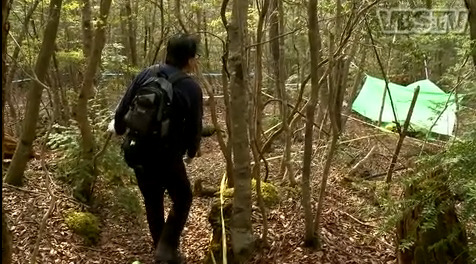
Japans Relationship with Nature
In the industrial cities of Tokyo, nature is hard to find as every inch of land is covered in concrete and has a modern building built on top of it. That being said, Japan has always had a harmonious relationship with nature as it plays a major role in their religion and landscape. Although technology has drifted them away from nature, they still protect and engage in it with activities such as forest bathing which is where you actively immerse yourself in a forest environment as it is proven to lower heart rate and blood pressure to relax you and release positive hormones. Nature is also continuously presented in traditional Japanese art, textiles and even architecture.
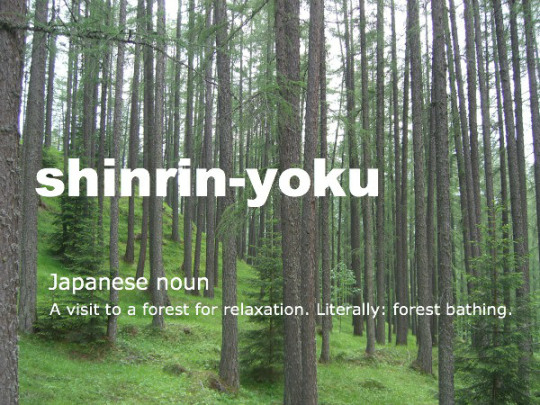
Japan’s relationship with mental health:
Up until the 90′s, Mental health in Japan wasn’t heard of outside of Psychiatric circles and depression was considered a physical condition rather than a mental one. Even today with the increase of mental health awareness in Japan, mental health is still not discussed and men are of high risk of suicide due to pressures of work and loneliness.

Menhara-chan designed by artist Bisuko
Yami Kawai (translates to sickly cute in english) is a Harajuku street style subculture from Japan promoting mental health awareness within their clothing and motifs. The Harajuku clothing style is very popular in Japan due to its use of bright childlike clothing and over use of accessaries and Yami Kawai dresses in a similar way mainly with the colour scheme of black and pastel pink. Their clothes are also covered in motifs that reference suicide and depressed feelings. The mascot of the subculture, Menhera-Chan designed by artist Bisuko created the character to be a stereotypical cute anime girl with undertones of suicide and self harm references in her design.
Yurei

A yurei’s appearance often differs depending on the circumstances on their death but they appear much like they did in their human life, retaining the features and the clothing they wore when they died or were buried, in most cases, white burial kimono’s or uniforms of fallen warriors. They also sometimes wear a white triangle on their head but this isn’t a very popular perception anymore. Occasionally they have bloody wounds indicative of the way they died and their hair is usually long if they are female. They are translucent and only very faintly visible, and in most cases they are so faint that they appear to have no feet.
They only haunt one particular place or person. In the case of a place it is often where they died or are buried and in the case of a person it is often their killer, or sometimes their loved ones. Yūrei only exist to haunt, and they remain “stuck” in this world until they can be put to rest. Some yūrei are so reluctant to accept their deaths that they haunt their living family, bringing misfortune and unhappiness for the rest of their family members’ lives.

Above is an interpretation from the 2002 Japanese horror film Ju-on; The Grudge, of a yurei.
Japanese spirits and supernatural creatures
List of potential Japanese spirits to explore:
Abura-akago – An infant ghost who licks the oil out of andon lamps.
Akateko – A red hand dangling out of a tree.
Arikura-no-baba – An old woman with magical powers.
Datsue-ba – An old woman in the Underworld who removes clothes (or skin if unclothed) of the dead.
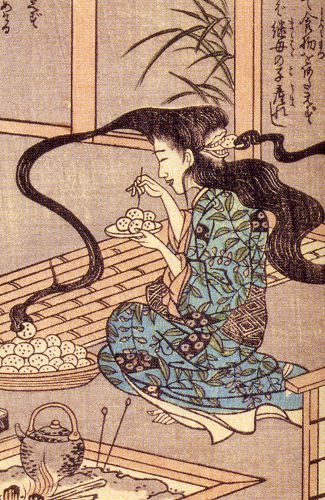
(Above)Futakuchi-onna – The two-mouthed woman.

(Above)Gashadokuro – A giant skeleton that is the spirit of the unburied dead. Also known as Gaikotsu.
Hanako-san – A spirit of a young World War II–era girl who haunts school restrooms.

(Above)Hannya – A noh mask representing a jealous female demon.
Hyakki Yakō – The demons night parade.
Jikininki – Ghosts that eats human corpses.
Jorōgumo – A spider-woman.
Jubokko – A vampiric tree.
Kodama – A spirit that lives in a tree.
Kubikajiri – Female corpse-chewing graveyard spirit.

(Above)Kuchisake-onna – The slit-mouthed woman.
Oiwa – The ghost of a woman with a distorted face who was murdered by her husband.
Onryō – A vengeful ghost formed from powerful feelings like rage or sorrow.


(1st picture is a representation of the creature, second image is a monster from movie Pan’s Labyrinth that’s appearance is similar to the first)Te-no-me – A ghost of a blind man with his eyes on his hands.


(Accurate representation above and a scene from 2005 film Memoirs of a Geisha. In this scene, the main character performs a dance that tells the story of a woman who suspects her husband of infidelity and waits outside in the snow to catch her husband leaving his mistress; unfortunately a blizzard sweeps over the land and she succumbs to the elements.) Yuki-onna- A ghostly woman who appears in snowfall.
Yama Uba/ mountain witch- an old crone who lives and hunts in the mountains and eats anyone who is unfortunate enough to cross her path.
Whilst exploring Japanese folklores and mythical creatures, I found many of them were represented as female. Unlike witches from European folklores, Japan doesn’t really have witches. They do have female Priestess’s/ shamans in the Shinto religion and Japans first ruler was a female shaman called Himiko.
What can I take away from this?
I was hoping to find some form of ghost related to suicide/ sorrow/ nature but sadly I didn’t find this. The reason I wanted to find some kind of forrest creature was so I could relate it back to the Aokigahara forest, but I only found different types of ghosts and spirits, none relating back to nature. However, I can look at this as an opportunity to use elements from Japanese spirits appearance and mix it with nature.
Artists who have explored Japanese Folklore and Mythology
Junji Ito
Japanese horror mangakas, Junji Ito, writes and illustrates short surreal, horror and gory comics with intricate panels and designs.

Inspired by the works of Kazuo Umezo, author of the violent and disturbing “God’s left hand, Devils Right”, and Koga Shinichi, whose work centres around Satanic worship and morbid depictions of the occults, Ito eventually developed his own unique style of writing and drawing of “in-escapable horror” (meaning the characters in his stories encounter entities completely by chance).


Ito’s work explores the manipulation and degradation of the human body, often distorting and deforming the form to become a mutated malevolent force. Working in pen and ink, the composition of his panels creates suspense with the use of the “page turn” where the last panel on a page is used as a cliff hanger so to warn the viewer that there will be something truly terrifying on the next.

He also explores the use of composition by arranging his characters in a specific manner. Like the above image, if you used the rule of thirds you can see that the main character, the one the audience are being forced to look at, is in the centre of the shot. However, she is smaller than the surrounding characters, meaning they have dominance over her and she is feeling vulnerable to them.


Uzumaki, is a three-volume manga by Jung Ito in which a village becomes haunted, not by ghosts however, but the geometric shape, the spiral. There is nothing frightening about a spiral, but Ito manages to create a threatening concept around it in which the shape begins to appear around the town and it eventually becomes the destruction of said place.

Work by Kazuo Umezo
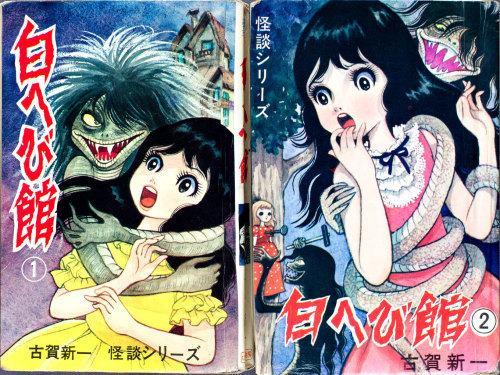
Work by Koga Shinichi
In comparison to his inspired artists, Ito’s work is more intense and although equally gory, he presents it in a more subtle and creepy manner. The art styles are also different, even though they are both manga, Ito chooses to not exaggerate his characters by giving them large exaggerated eyes and gives them a more plain appearance.
destroyraccoon/ Helena Smołka
Polish illustrator and animator, Helena Smotka is inspired by Asian urban legends which she interprets with her psychedelic cartoon character designs and short videos.
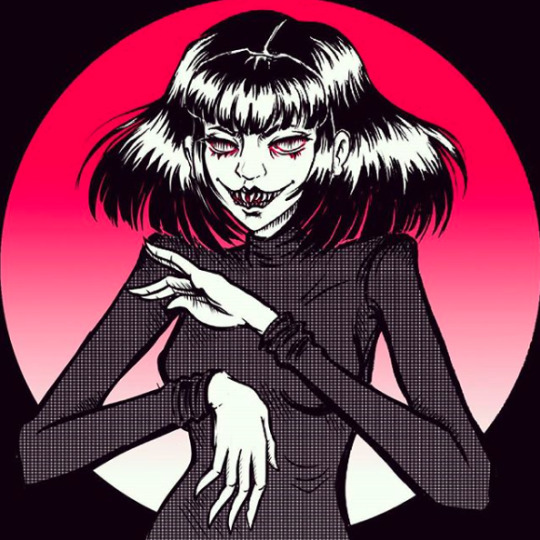
Like Junji Ito, Smotke creates an intense style of work that, although is less gruesome than Ito’s, is still heavily exaggerated to the point of scary with sharp and stretched limbs and facial expressions that are clown like and creepy.
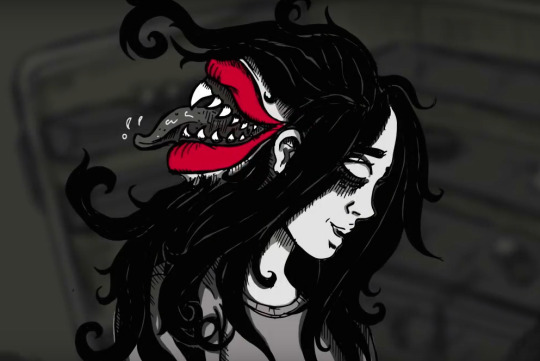
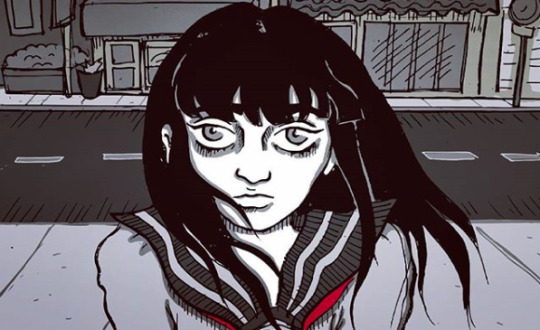
Inspired by urban legends and creatures like the two mouthed woman, Smotke creates short animations using a monochrome, black and white colour scheme with touches of red to create an uneasy and tense atmosphere. Although the touches of red don’t always symbolise a certain object of suspicion, it is used in a way that allows you to slowly become used to the red to put the viewer in a false sense of comfort before using the colour to show/ represent the monstrous creature entirely.
Mau Lencinas
Argentinian artist and illustrator, Mau Lencinas creates a mashup of traditional Japanese ghost symbology, hip-hop retro-futurism, and urban street couture to create illustrations, character designs and 2D animations. Mostly inspired by animated movie, Akira, creator Katsuhiro Otomo and the urban style of our nascent neo-modern era, Lencinas creates a series of demonic gangsters bearing kanji symbols, and crews of demon hunters adapted from Japanese traditional folklore.

Lencinas draws his characters from the idea of a dystopia Tokyo, he dresses his characters in fashionable street wear before arming them with Samurai swords and ninja weaponry, adding traditional Japanese masks to their clothing and having them battle demons from Japanese folklore. He works in bright saturated colours with little 3D dimension to add to the playful nature and the youth of the characters and works in digital software which creates a neat finish which he wouldn’t have gotten from a hand rendered process.
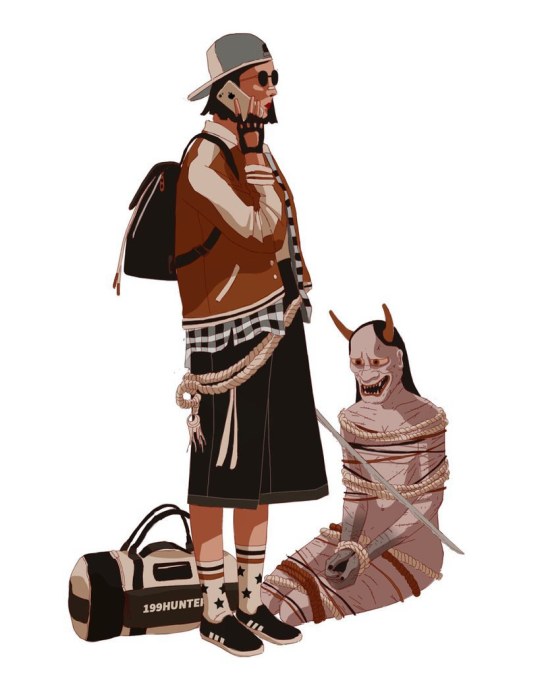

Unlike the artists I explored above, Lencinas’ work isn’t horror related but he explores the process of mixing too themes together to create unique character designs. I want to attempt to design a ghost to represent the Aokigahara forest so I will be mixing the use of nature with the traditional appearance of a Japanese ghost. Lencinas, also incorporates street fashion and traditional Japanese clothing to dress his characters, which is perhaps something I try to include by exploring Geishas and kabuki theatre.
Reflection
Pleased with the development I have made with my observational drawings, I want to continue to develop them into characters or witches, however, now that I have looked at the Aokigahara forest and yureis, I’m inspired to mix the two subjects together to create a spiritual forest being. I can use the observational sketches as a template for these designs and as I want to set them in Japan I should look into the culture such as traditional art and clothing. As I am still keen to progress on my subject of witchcraft, I will try to create my forest spirit with witch like elements or look at other female creatures that lure or cast spells.
Actions
1. Look at how witchcraft has been documented in art in history
2. Use drypoint to create more illustrative pieces
3. Look at 4D processes like stop motion and explore artists related to the process
4. Explore Japanese culture through traditional art and clothing
5. Begin to create designs for my forest spirit/ witch
6. ADDRESS AUDIENCE AND CREATE A QUESTIONNAIRE TO SEE WHAT THEY WOULD LIKE FROM MY DESIGNS
Sources
Websites
Mental Floss, 10 Horrifying Demons and Spirits from Japanese Folklore, http://mentalfloss.com/article/59737/10-horrifying-demons-and-spirits-japanese-folklore accessed on 30.4.18
Mental Floss, 15 Eerie Things About Japan's Suicide Forest, http://mentalfloss.com/article/73288/15-eerie-things-about-japans-suicide-forest accessed on 30.4.18
BBC, Why does Japan have such a high suicide rate?, http://www.bbc.co.uk/news/world-33362387 accessed on 30.4.18
Creators, Streetwear Illustrations Dive into a Dystopian World of Demon Hunters, https://creators.vice.com/en_au/article/jpvy98/japanese-streetwear-demon-hunters-gangs-drawings accessed on 30.4.18
Behance, Helena Smotka, https://www.behance.net/hsmolka accessed on 30.4.18
Youtube, destroyraccoon, https://www.youtube.com/channel/UCQvfxe-hQUarvVfhzh3tCFQ accessed on 30.4.18
BBC News, How Japan came to believe in depression, http://www.bbc.co.uk/news/magazine-36824927 accessed on 3.5.18
Youtube
VICE (2012), Suicide Forest in Japan, https://www.youtube.com/watch?v=4FDSdg09df8 accessed on 30.4.18
Super Eyepatch Wolf (2016), How Media Scares Us: The Work of Jung Ito, https://www.youtube.com/watch?v=lIIA6QDgl2M accessed on 30.4.18
Super Eyepatch Wolf (2018), The Jung Ito Collection is Disappointing Garbage, https://www.youtube.com/watch?v=DAYFi6bLSfs&t=488s accessed on 30.4.18
Refinery29 (2018), The Dark Side Of Harajuku Style You Haven't Seen Yet | Style Out There | Refinery29, https://www.youtube.com/watch?v=1Wsk3Oa_3F8 accessed on 3.5.18
0 notes